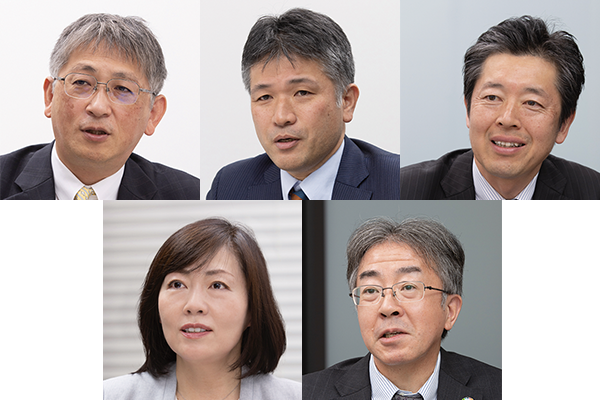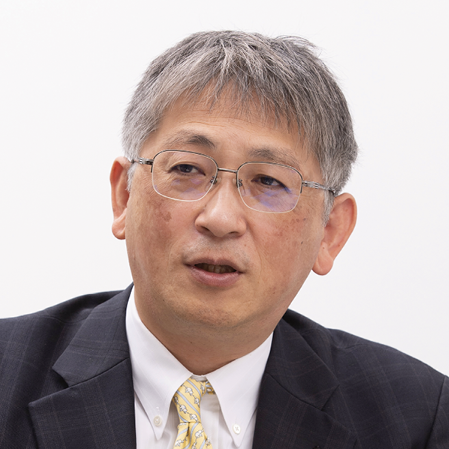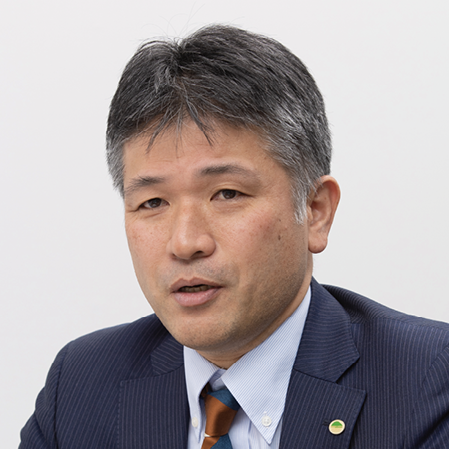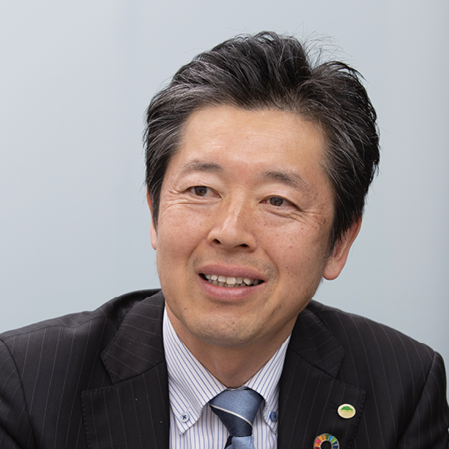COVER STORY:CONCEPTSustainable Future Built on Multifaceted CoordinationDigital Solutions for Resource Recycling and Decarbonization
Highlight
As the global environment undergoes dramatic change, humanity is confronted with numerous challenges in the form of climate change, energy concerns, and resource depletion. To overcome these global-scale issues, it is essential for everyone living on Earth to have a sense of ownership and that all nations act in a globally coordinated manner. Against this background, Hitachi is developing environmentally conscious technologies and solutions and is engaging in collaborative creation with corporate partners and other stakeholders as it seeks to create a sustainable society. Hitachi Review invited Professor Masaki Takaoka of the Environmental Engineering Department, Graduate School of Engineering, Kyoto University, who also serves on the Working Group for a Sound Material Cycle Society, Central Environment Council, Ministry of the Environment, to meet with key people from Hitachi and review the progress of work on global environmental protection and also look ahead to what forms a sustainable future society might take.

Distinguishing Global Challenges from Local Challenges and Considering Them Together
 Masaki Takaoka,Ph.D.
Masaki Takaoka,Ph.D.
Professor, Environmental Engineering Department, Graduate School of Engineering, Kyoto University
After being appointed Assistant Professor at the Faculty of Engineering, Kyoto University in 1993, he served as an Associate Professor and in other roles before taking up his current position as Professor of Environmental Engineering. Member of the Working Group for a Sound Material Cycle Society, Central Environment Council, Ministry of the Environment, Vice-President from June 2022 of the Japan Society of Material Cycles and Waste Management
EmbutsuThe keywords of decarbonization and resource-efficiency have attracted considerable attention in the context of achieving a sustainable society. Back in the 1960s, the term “pollution” was used for the environmental problems of the time. Hitachi has grappled with a wide variety of challenges since then, right up to the present-day issue of climate change. While environmental challenges are challenges for all of humanity, we tend to see them differently depending on our particular standpoint or perspective. Professor Takaoka, how do you see the circumstances surrounding the environmental challenges of today from your perspective in the field of environmental engineering?
TakaokaFifty years ago, in 1972, the Club of Rome*1 published its first major report, “The Limits to Growth.” The report made the case that, “If the present growth trends in world population, industrialization, pollution, food production, and resource depletion continue unchanged, the limits to growth on this planet will be reached sometime within the next one hundred years.” Since then, there has been concern about the depletion of resources such as metals and fossil fuels. The limits of planet Earth are something we need to be thinking about on the basis of scientific knowledge, asking how we can make effective use of finite resources.
As you noted, people perceive environmental challenges differently depending on their particular perspective. While this requires us to distinguish between local challenges and those that matter to the entire world, this does not mean the two are unrelated. One example is the question of how to dispose of artificial materials such as plastics. Seen as a local matter in the past, the issue is increasingly becoming global in scope and negotiations for an international convention on plastic pollution are currently underway. On the other hand, as different localities address environmental challenges differently and have their own forms of social infrastructure, resource recycling needs to be achieved in ways that best suit their respective circumstances.
While climate change, for example, is a major challenge that Japan shares with the rest of the world, it also faces a parallel problem in the form of a shrinking population. At the same time as population increase is pushing societies around the world in the direction of higher consumption of resources such as food, Japan faces a shrinking number of consumers. It seems unlikely that both problems can be resolved through a common approach.
EmbutsuWith environmental conventions and other such measures being taken globally, where do you see scope for Japanese manufacturers to exert influence?
TakaokaI believe that Japan is a leader in the disposal of environmental pollutants. On the other hand, there have been some remarkable advances made overseas in technologies for dealing with plastics. Rather than continuing to use existing recycling technologies and systems, Japan also needs to be upgrading its practices to keep pace with current progress.
The European Union (EU) has proposed the idea of a circular economy*2 whereby it is seeking to make solutions to the issue of environmental pollution an integral part of the economic system, including through the use of digital technologies that were not even imagined in the 2000s. In Japan, not only do we need to catch up with international developments while facing up to these societal changes, but we also need to take advantage of our own distinctive strengths to serve as a model for what new solutions might look like.
- *1
- A private-sector think tank headquartered in Winterthur, Switzerland.
- *2
- An economic system in which materials and products are recycled and economic growth is combined with a reduction in waste and pollution.
Hitachi’s Efforts to Balance Environment and Business
 Makoto Onishi
Makoto Onishi
CTO, Water & Environment Business Unit, Hitachi, Ltd.
Graduated from the Division of Environmental Engineering, School of Engineering, Osaka University in 1986. Joined Hitachi Plant Engineering & Construction Co., Ltd. in 1986. He has worked on water treatment systems, especially the research and development of systems that use membrane separation. He took up his current position in 2019.
 Hideki Hanami
Hideki Hanami
CTO, Industrial Digital Business Unit, Hitachi, Ltd.
Joined Hitachi, Ltd. in 1994. Worked on digital control systems and security for critical infrastructure at Omika Works before taking up his current position in April 2022. In addition to his participation in Working Group 3 at the Study Group for Industrial Cybersecurity led by the Ministry of Economy, Trade and Industry, he has also worked to promote the digitalization of manufacturing as a member of the World Economic Forum (WEF) Global Lighthouse Network.
EmbutsuAlong with national and regional differences, there are also different standpoints, such as those of academia and the private sector, on how to think about and address the problem of environmental protection. Onishi-san and Hanami-san, how do you see this from a business unit perspective? Also, can you tell us about what your respective divisions within Hitachi are doing about this?
OnishiIn our 2024 Mid-term Management Plan, Hitachi set targets of achieving carbon neutrality at all our business sites (factories and offices) by FY2030 and throughout our value chain by FY2050. To help customers reduce their carbon footprint, we have also set explicit numeric targets for our contribution to carbon dioxide (CO2) reduction in FY2024. In the Water & Environment Business Unit where I work, our business primarily involves things like tendering for engineering projects, such as water infrastructure for public sector utilities in Japan and our utilities solution business for industrial customers.
One thing that I have noticed through my involvement in this work is that public perceptions of resource recycling are changing significantly, both within Hitachi and among our customers. A lot of people have started to question why we can’t create useful resources out of things that used to be disposed of or treated. For example, rather than asking how we can treat wastewater, people are wanting to know how wastewater can be processed, recycled, and reused to serve as a resource.
In the past, our business was primarily based on two-way relationships, between Hitachi and local governments in the case of the public sector and between Hitachi and companies in the industrial sector. In order to get serious about resource recycling, however, I believe we need to build systems that take account of a wide range of stakeholders, including suppliers of parts and materials and the end users who actually use the products, and indeed we are currently working to do so.
HanamiWhile the industrial workplace is seeing significant advances driven by new technologies such as digital twins, I believe we have now reached a point where we need to take the next step toward resolving societal challenges.
Meanwhile, supply chains in industry encompass many stakeholders, from materials production to the manufacturing and assembly of parts and transportation to the end user, with the various participants addressing environmental issues based on their own standpoints. Each company operates its business on the basis of its own key performance indicators (KPIs), a way of doing things that is not always optimal when considering the totality of the supply chain. While individual companies will continue doing what makes sense in their own context, what has to happen next, I believe, is for us to start thinking about how to optimize the supply chain as a whole.
The key to achieving this will be common platforms that share data in cyberspace and are capable of intelligently analyzing the entire supply chain. One example relating to CO2 emissions would be a mechanism for presenting and sharing information on how much CO2 has been emitted in the process of making and supplying particular parts or products, something that is difficult for users to find on their own. If this platform could be combined with accurate demand prediction, I believe it could boost efficiency along all steps in the supply chain from the supply of parts and materials to distribution and delivery.
In anticipation of such mechanisms, we are working at the Industrial Digital Business Unit to create value by linking together the different types of data generated in industry and in other places where economic activity happens. Along with collecting and coordinating data and running simulations, we are creating robust and resilient supply chains by encouraging improvement not only in the vertical direction from the company workplace up to senior management, but also horizontally across different companies. To achieve this, we are working not only on the management of production lines in physical space, but also on developing enterprise resource planning (ERP) platforms for management and on the optimization of supply chain planning.
EmbutsuSo, what you are talking about is the use of digital technology to optimize and operate entire supply chains beyond what any one company can do on its own. In this context, what is happening in the area of international standardization?
HanamiThere were discussions in Europe several years ago about establishing rules for disclosing how much CO2 is emitted in the process of manufacturing particular products. Vendors have already started to make platforms available that conform to the Gaia-X*3 data sharing rules and the number of participating companies is rising. Similar activities have also gotten underway in Japan, including work on establishing rules for the sharing of data on the emission of CO2 in manufacturing processes and how these numbers are to be calculated. Attention is also being paid to maintaining consistency with international rules, with the Ministry of Economy, Trade and Industry and the Ministry of the Environment participating as observers at organizations such as the Green × Digital Consortium*4.
- *3
- A European project for building data infrastructure with the primary objective of securing digital sovereignty. The aim is to enable interoperability by integrating diverse cloud services supplied by companies both inside and outside of Europe on a common system, with a standardized certification mechanism that facilitates the exchange of data across industries.
- *4
- A consortium dedicated to the comprehensive optimization of Japanese industry and society to help achieve carbon neutrality by 2050, including through digitalization and the creation of new business models in environmental industries.
Resource Recycling for Maintaining Growth in a Finite World
 Tomoko Suzuki,Ph.D.
Tomoko Suzuki,Ph.D.
Project Leader, Planetary Boundaries Project, Center for Sustainability, and Corporate Chief Scientist, Research & Development Group, Hitachi, Ltd.
After joining Hitachi, Ltd., she worked on an extensive range of environmental system developments, including systems for hydrogen production and for generating power from waste. In her current role, she is engaged in the formulation and commercial implementation of research and development strategies for resolving environmental challenges.
 Moderator
Moderator
Ichiro Embutsu,Ph.D.
Principal Researcher, Center for Sustainability – Decarbonized Energy, Research & Development Group, Hitachi, Ltd.
He is currently engaged in the research and development of water and environmental systems. His appointments include being a member of the Judging Panel on the Project Innovation Awards (PIA) by the International Water Association (IWA) and Vice President of the Society of Environmental Instrumentation, Control and Automation (EICA). Doctor of Engineering
EmbutsuAmong the challenges facing the environment are problems that are not amenable to quick resolution using existing systems and solutions. Goals such as decarbonization and resource recycling demand a higher level of technology than is found in the environmental solutions that business is currently able to supply. What work has the Research & Development Group been doing in this regard?
SuzukiOur core strategy at the Research & Development Group is to utilize data and collaborative creation to overcome the challenges facing customers and wider society, thereby helping to resolve the issues associated with planetary boundaries*5 and with well-being. Two projects that commenced during the current fiscal year were the Planetary Boundaries Project and the Well-being Project. While planetary boundaries can be thought of as representing the limits of the earth, we take a forward-looking approach that asks how we can learn where these boundaries lie and how we can continue to grow without exceeding them. In the area of climate change, along with research based on forecasting from current societal systems, such as work toward use of non-fossil fuels, the electrification of mobility, and energy efficiency, we are also identifying areas that warrant attention by backcasting from the sort of society we want to have in 2050, and working on utilizing hydrogen as a source of energy to help achieve carbon neutrality.
With regard to well-being, the ability to choose for one’s self is a vital factor in people’s sense of self-esteem. It is important for people to have a range of possible futures and to be able to choose between them. To this end, we have also been working on the use of a policy recommendation artificial intelligence (AI) to present a number of future scenarios that suit different localities to help build community consensus and inform decision-making on policy.
EmbutsuYou are talking about how to help people decide what they should be doing now in anticipation of the future and which path they should follow. I think it is a very admirable endeavor to be able to support government and other decision-making about policy and other matters based on scientific knowledge.
Professor Takaoka, how do you see the future of environmental protection from the perspective of environmental engineering?
TakaokaThe term “circular economy” is one that we frequently hear in recent years. If such an economy were truly circular, it would have no arteries (outflows) or veins (inflows). Currently, however, we still have businesses that operate like arteries (using fresh resources) and others that operate like veins (able to recycle and reuse existing resources). If we are to achieve genuinely cyclic use of resources then those artery companies will need to take active steps to use only resources that are already available. Suzuki-san spoke earlier about the technique of backcasting and in that context what we want is a world where it is not possible to distinguish the arteries from the veins.
EmbutsuThe term “waste treatment” will disappear and terms like resource recovery and the trading of valuable materials will take its place. The ideal will be a society in which, rather than being considered waste, sewage and sludge will be seen as treasure troves.
SuzukiUnfortunately, the distribution and use of recycled materials also pose problems. For a waste material discharged by one industry to be used in another, for example, it first needs to satisfy a number of requirements set by that other industry, such as standards governing input materials. To address this issue, we partnered with the National Institute of Advanced Industrial Science and Technology (AIST) to establish the Hitachi-AIST Circular Economy Cooperative Research Laboratory in October 2022. To create a circular economy that can make efficient use of resources across entire value chains that span different industry sectors, we are undertaking research and development on topics such as determining what sort of society we want and what rules it will require.
- *5
- A concept that attempts to quantify the safe boundaries of human activity on Earth within which humanity can continue to develop and thrive.
Changing Now to Achieve the Future We Imagine
EmbutsuFinally, could you tell me about your outlooks for the future. Could you start by telling me about your plans at Hitachi.
OnishiAt the Water & Environment Business Unit, our future plans for managing and reducing CO2 emissions start with measures to clarify the origins of recycled resources and provide the ability to track a variety of emissions and other data relating to the production process. We want to create value for our customers not only within Hitachi, but also through collaborative creation with our corporate partners and other stakeholders. On the technology front, we are currently working with local governments on the use of hydrogen as a low-carbon source of energy. The aim is to enable the energy consumed in a region to be produced locally by utilizing local photovoltaic power generation to produce hydrogen that can then be stored in hydrogen storage alloy cassettes and supplied to users via the existing networks of consumer cooperatives and other such organizations for use in on-site power generation. We are also leveraging biotechnology, another strength of Hitachi, to enter the field of bio-production. This involves the use of biotechnology to produce a wide range of chemicals and other such products from biomass, biologically derived material that does not compete with food.
HanamiGiven that environmental challenges are not amenable to resolution at a single stroke, the way to approach them, we believe, is first to support the work being done by different companies to overcome these challenges and then to move on to the next step of optimizing activities across the entire value chain. The reliability of data plays a crucial part when it comes to making systems more sophisticated by leveraging the capabilities of digital technologies that encompass both the cyber and physical worlds. Sharing data between stakeholders serves no useful purpose if the data cannot be trusted. One example relates to the Hitachi value chain traceability service for regenerative medicine supplied by the Industrial Digital Business Unit. Because it contains personal information, any mishandling of data from the field of regenerative medicine is unacceptable and it needs to be treated with extreme care. The various steps along the value chain are linked together using encryption techniques and traceability to keep pace with the ever-changing situation on the ground. With the concept of trust being built into the process, this involves the appropriate sharing of data acquired by accurate measurements made using rule-compliant means. By doing so, I hope that we can help to protect the environment by improving operational efficiency along all steps of the value chain while also contributing to well-being in the broader sense of the safety and security of users.
SuzukiThe growth in global population is expected to peak in the 2080s*6. As the population grows, it follows inevitably that demand for food and other resources will grow with it. This is predicted to worsen deforestation as people seek more land for agriculture. The questions of how to acquire resources and put them to effective use are becoming more important than ever. At the Research & Development Group, we have taken up the challenge out of a belief in the necessity of treating CO2 as a resource that can be used to produce feedstocks for the production of food or materials. It would be wonderful if we could put biotechnology and digital technology to use in synthesizing materials able to be used in the production of food, clothing, or shelter. This idea is one of a number of research topics aimed at turning CO2 into a resource that we are undertaking in partnership with the University of Cambridge in the UK as well as with a variety of private sector companies and startups.
EmbutsuWhat about how things look from academia? What can you tell us about future targets for environmental problems and the challenges that arise when putting ideas into practice?
TakaokaSocial infrastructure is not something that can be changed easily. If the current state of progress is all about innovation achieved by applying the various technologies of digital transformation (DX) to existing social infrastructure, then decarbonization and carbon neutrality are one step further on from that. Both universities and private-sector companies need to be serious about pursuing research and development that looks ahead to the future of 2050. A variety of approaches can be used to overcome challenges, such as the recycling of water and waste products, recycling carbon in order to achieve carbon neutrality, and biotechnology. Which of these approaches will work best, however, will depend on the size and characteristics of the society concerned. I hope we can continue to try a range of different initiatives in the future as we seek out the best solutions without fear of the risks.
The development of human capital is another role of universities. Societal challenges and environmental problems are not issues that can be resolved by Japan on its own, and we need to be fostering people with a global perspective on society and the environment, not just through our research, but also through practices such as international exchange, and then send these people out to work in the private and public sectors. I hope that we can continue to enjoy close collaboration between industry, government, and academia that addresses both technology and human capital.
EmbutsuHaving people among our customers who care about overcoming environmental challenges changes the conversation entirely, and for this reason I would like to see more fostering of human capital by universities. We also hope to proceed through collaborative creation based on a deep understanding of the challenges facing customers, making good use of the scientific knowledge and human capital that exists in academia. Thank you for your time today.



